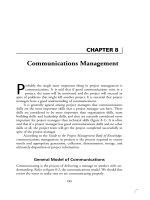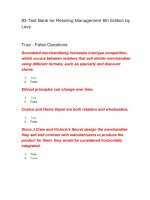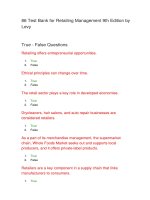Lecture Retailing management (6e) Chapter 8 Levy Weitz
Bạn đang xem bản rút gọn của tài liệu. Xem và tải ngay bản đầy đủ của tài liệu tại đây (2.63 MB, 49 trang )
Chapter 8
Retail Site Location
McGraw-Hill/Irwin
Retailing Management, 6/e
Copyright © 2007 by The McGraw-Hill Companies, Inc. All rights reserved.
8-2
Retailing Strategy
Human Resource
Management
Chapter 9
Retail Market and
Financial Strategy
Chapter 5, 6
Retail Locations
Chapter 7
Site Locations
Chapter 8
Information and
Distribution
Systems
Chapter 10
Customer
Relationship
Management
Chapter 11
8-3
Location Chapters
• Chapter 7
– General Description of the Location Types
– Advantages and Disadvantages of Different
Location
• Chapter 8
– Considerations in Selecting Area for Locating
Store
– Issues in Evaluating Specific Sites
Factors Affecting the Demand for a
Region or Trade Area
8-4
8-5
Economic Conditions
It is important to examine an area’s level and growth of population and employment
8-6
Competition
Some retailers are going urban:
Lack of competition
High level of disposable income
Large, untapped labor force
The McGraw-Hill Companies, Inc./John Flournoy, photographer
8-7
Strategic Fit
Ann Taylor – High income, dual career families
Hot Topic – teen, pop culture, grunge
Royalty-Free/CORBIS
McDonald’s – families with kids
REI – outdoor enthusiasts
The McGraw-Hill Companies, Inc./John Flournoy,
photographer
8-8
Operating Costs
• Varies across areas
• Affected by proximity of
area considered vs.
other areas
where retailer operates
• Local and state legal
environment has effect
Nick Koudis/Getty Images
8-9
How Many Stores to Open in an Area?
Economies of Scale
One promotional costs for all stores
as
vs.
Cannabilization
open stores as long
profits increase
Justifies cost of distribution center
Increases sales per store
Target needs of regional market
Management has control of market
810
Evaluating a Site
When evaluating and selecting a specific site, retailers consider:
Stockbyte/Punchstock Images
•The characteristic of the site
•The characteristic of the trading area
•The estimated potential sales that can be generated
Site Characteristics
811
Traffic Flow and Accessibility
812
When traffic is greater, more
customers shop
Good for convenience retailers
Not necessary for destination
retailers
Too much can impede access to
store
Accessibility to store is as
important as traffic flow
PhotoLink/Getty Images
Convenience of Going to Site
Accessibility
• Road pattern and condition
• Natural and artificial barriers
• Visibility
• Traffic flow
• Parking
• Congestion
• Ingress/egress
©McGraw-Hill Companies/Jill Braaten, photographer
813
814
What Should Retailers Consider for Parking?
Observe shopping center at various times
Employee parking availability
Shoppers that use cars
Parking by non-shoppers
Typical length of a shopping trip
The McGraw-Hill Companies, Inc./Andrew Resek, photographer
Adjacent Tenants
• What other retailers would Radio Shack
want to be located near?
– Wal-Mart, Supermarket, Best Buy?
• In an enclosed mall, what retailers would
Abercrombie & Fitch want to be located
near?
– American Eagle Outfitter, Ann Taylor, Body
Shop, Electronic Boutique
• Principle of Cumulative Attractiveness
815
816
Grouping Retailers in an Enclosed Mall
Cost and Restrictions
817
• Costs
– Rent
– Common Area Maintenance Fee/Insurance
– Advertising Fee
• Restrictions
– Signage
– Tenant MIx
– Operating hours
818
Steps in Evaluating Sales Potential of a Site
• Define Trade Area
– Drive Time vs. Geographic Distance
– Primary, Secondary, Tertiary
• Estimate Sales Potential
– Huff Model
– Analog Approach
– Regression Analysis
Zones in a Trade Area
819
Trade Area
820
Primary zone - 60 to 65 percent of its customers
Secondary zone - 20 percent of a store’s sales
Tertiary zone - customers who occasionally shop
at the store or shopping center
U.S. Geological Survey, ESIC
Factors Defining Trade Areas
•Accessibility
•Natural & Physical Barriers
•Type of Shopping Area
•Type of Store
•Competition
•Parasite Stores
821
Measuring Trade Areas
Customer Spotting
Use Census Data
Geodemographic Information
Systems
Information on Competition
– Yellow Pages
822
Customer Spotting
Purpose: to spot, or locate, the residences of
customers for a store or shopping center.
How to obtain data:
• credit card or checks
• customer loyalty programs
• manually as part of the checkout process
• automobile license plates
823
Census Data of the U.S.
824
Only once in 10 years.
Ryan McVay/Getty Images
Each household in the country is
counted to determine the number
of persons per household,
household relationships, sex,
race, age and marital status.
Geographic Information System (GIS)
825
GIS – a system of hardware and software used to store,
retrieve, map and analyze geographic data along with the
operating personnel and the data that goes into the system.
• coordinate system (latitude and longitude)
• spacial features (rivers and roads)
• some firms offer services combine GIS with updated
census data, consumer spending patterns and lifestyles









